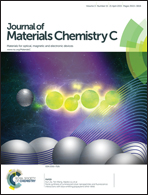Enhanced piezoelectric activity in high-temperature Bi1−x−ySmxLayFeO3 lead-free ceramics
Abstract
We have developed a high-temperature bismuth ferrite ceramics with enhanced piezoelectric activity by chemical modifications, that is, the Bi1−x−ySmxLayFeO3 (0 ≤ x ≤ 0.30 and 0 ≤ y ≤ 0.15) lead-free ceramics were prepared by a conventional solid-state method. The influences of La and Sm content on their microstructure and electrical properties were systematically investigated. The ceramics with 0 ≤ x < 0.10 (y = 0.05) or 0 ≤ y ≤ 0.15 (x = 0.025) belong to a triclinic phase, and a mixed structure with rhombohedral-like and orthorhombic phases was found in the ones with 0.10 ≤ x ≤ 0.30 (y = 0.05). The electrical properties of the ceramics can be operated by refining the x and y values. A very low dielectric loss (tan δ ∼ 0.43%) was shown in the ceramics with x = 0.025 and y = 0.05 because of the involvement of low defect concentrations. In addition, the ceramics with x = 0.025 and y = 0.05 also possess a high piezoelectric activity (d33 ∼ 50 pC N−1), which is larger with the respect to the previously reported results in high-temperature piezoceramics with a Curie temperature of >600 °C, and a better thermal stability of piezoelectricity in 20–700 °C is also shown. We believe that this material system is suitable for high-temperature piezoelectric applications.


 Please wait while we load your content...
Please wait while we load your content...